Haryana State Board HBSE 6th Class Science Solutions Chapter 12 Electricity and Circuits Textbook Exercise Questions and Answers.
Haryana Board 6th Class Science Solutions Chapter 12 Electricity and Circuits
HBSE 6th Class Science Electricity and Circuits Textbook Questions and Answers
Exercises
Question 1.
Fill in the blanks:
(a) A device that is used to break an electric circuit is called ………… .
(b) An electric cell has …………. terminals.
Answer:
(a) switch
(b) two.
Question 2.
Make ‘true’ or ‘false’ for following statements:
(a) Electric current can flow through metals.
(b) Instead of metal wires, a jute string can be used to make a circuit.
(c) Electric current can pass through thermocol.
Answer:
(a) True
(b) False
(c) False.
![]()
Question 3.
Explain why the bulb not glow in the arrangement shown in Fig. 12.1.
Answer:
The bulb would not glow in the arrangement shown in figure because the one end of tester/screw driver is made up of plastic which does not allow the electric current of flow through it.

Question 4.
Complete the drawing in Fig 12.2. to indicate where the tree ends of the two wires should be joined to make the bulbs glow.
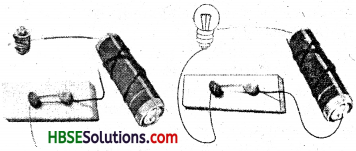
Question 5.
What is the purpose of using an electric switch? Name some electrical gadgets that have switches built into them.
Answer:
An electrical switch is used to open the circuit or to close the circuit due to which electrical gadgets start or stop. Electrical switch is used in many electrical gadgets such as: Television, Washing machine, Electrical mixy, Toaster, Heaters, Press, Tube-light, Electrical bulb, Torch, etc.
Question 6.
Would the bulb glow after completing the circuit shown in Fig. 12.13 if instead of safety pin we use an eraser?
Answer:
No, since eraser is an insulator so it does not allow the current to pass. Hence, the bulb will not glow.
Question 7.
Would the bulbs glow in the circuit in Fig. 12.5.
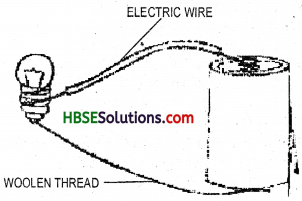
Answer:
No, the bulb will not light up. Because on one terminal, woolen thread is used instead of metal wires. Woollen thread is insulator in which no current flows. So the bulb will not light up.
Question 8.
Using your “conduction tester” on an object is was found that the bulb begins to glow is that a conductor or an insulator? Explain.
Answer:
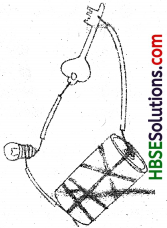
The bulb lights up, when we use “conductor tester”, because the material we use is conductor. The material is made up of metals which are conductors of electricity. Therefore the bulb lights up. The circuit completes due to flow of electricity through metal materials. (See Fig. 12.6.)
Question 9.
Why should an electrician use rubber gloves while repairing an electric switch at your home? Explain.
Answer:
Our body is good conductor of electricity and rubber in insulator. During repairing work if the body comes in contact with current carrying wire then there will not be any accident as rubber does not allow the passage of current though it. Hence electrician uses rubber gloves while repairing an electric switch.
Question 10.
The handles of the tools like screwdrivers and pliers used by electricians for the repair work usually have plastic or rubber covers on them. Can you explain why?
Answer:
Plastic or rubber is an insulator which does not allow electric current to pass through it. The handles of the tools like screwdrivers and pliers used by electricians have covering of plastic or rubber, so that electric current may not pass through these tools to the body of the electrician to harm him.
![]()
HBSE 6th Class Science Electricity and Circuits Important Questions and Answers
Very Short Answer Type Questions
Question 1.
Define electricity.
Answer:
Electricity is one of the most useful forms of energy.
Question 2.
Name two devices which work on electricity?
Answer:
(i) Toaster
(ii) Television.
Question 3.
From where is electricity supplied to our home?
Answer:
Electricity is supplied to our home from power station.
Question 4.
When electricity supply fails at night, from where do we get electricity?
Answer:
When electric supply fails at night, we get electricity from torch.
Question 5.
What supplies electricity to torch bulb?
Answer:
Electric cell supplies electricity to torch bulb.
Question 6.
What is an electric cell?
Answer:
It is a source of electricity.
Question 7.
Name two devices in which we use electric cell?
Answer:
(i) Alarm clock
(ii) Camera.
Question 8.
What type of terminals does an electric cell contain?
Answer:
Two types of terminals:
(i) Positive terminals (+) and (ii) Negative terminals (-).
Question 9.
Define battery.
Answer:
When two or more cells are joined together, we call it a battery.
![]()
Question 10.
How does an electric cell produce electricity?
Answer:
An electric cell produces electricity from chemicals stored inside it.
Question 11.
When does the electric bulb light up?
Answer:
Electric bulb lights up when the bulb and the connecting wire form a complete path which starts from one terminal of the electric cell and ends at the other terminal.
Question 12.
If there is any gap in the path, will the bulb light up?
Answer:
The bulb will not light up.
Question 13.
Define an electric circuit.
Answer:
The complete path from one terminal of the electric cell through the bulb and back to the other terminal of electric cell is called, a circuit.
Question 14.
In which direction does electric current flow in a circuit?
Answer:
Electric current flows in a circuit from positive terminal to negative terminal.
Question 15.
What is a fused bulb?
Answer:
When the filament is broken in a bulb, it is called the fused bulb.
Question 16.
What is an electric switch?
Answer:
A switch is a simple device that either breaks or completes the circuit.
Question 17.
Define an open circuit.
Answer:
When there is a gap between two terminals, it is called open circuit.
Question 18.
What is a closed circuit?
Answer:
A circuit where there is no gap between two terminals is called a closed circuit.
Question 19.
Define conductors.
Answer:
The materials through which electric current can flow are called conductors.
Question 20.
What are insulators?
Answer:
The materials through which the electric current cannot flow are called insulators.
Question 21.
Name two materials which are condutors.
Answer:
(i) Aluminium
(ii) Copper.
Question 22.
Name two insulators.
Answer:
(i) Rubber
(ii) Plastics.
![]()
Question 23.
Can we use rubber/jute instead of metal wires to connect circuit?
Answer:
No, we cannot use rubber/jute to connect circuit wires.
Question 24.
Name two metals which can be used to connect wires.
Answer:
(i) Copper
(ii) Aluminium.
Short Answer Type Questions
Question 1.
Classify the following into conductors and insulators:
Metal, Rubber, Plastic, Wood, Glass, Iron nail, Gold foil.
Answer:
(a) Conductors: Metals, iron nails, gold foil.
(b) Insulators: Rubber, plastic, wood, glass.
Question 2.
Why are copper and aluminium metals used for making wires?
Answer:
Copper and aluminium are metals. They are good conductors of electricity and electric current can flow through them. So they are used for making electric wires.
Question 3.
Name two insulators and two conductors.
Answer:
Insulators:
(i) Plastic
(ii) Rubber.
Conductors:
(i) Iron
(ii) Copper.
Question 4.
Name some devices in which electric cell is used.
Answer:
We use electric cell in many devices; such as alarm clock, wrist-watch, transistor, calculator, camera, lighter etc.
Question 5.
Define an electric cell.
Answer:
An electric cell contains a cylindrical pot covered by a thick paper sheet. Inside the a pot, there are some chemicals stored and a carbon rod in the middle covered by metal cap at its top. There are two terminals: (+) positive and (-) negative terminals in the cell. The (-) negative mark is negative terminal of the cell. Both terminals are on the same side. (See Fig. 12.7.)
Question 6.
Define a battery.
Answer:
When two or more electric cells are joined in such a way that positive terminal of one cell is joined by negative terminal of another cell, we call it a battery. (See Fig. 12.8.)
![]()
Question 7.
How does an electric cell produce electricity?
Answer:
Electricity is-produced by electric cell from chemicals stored inside it. When the chemicals of the cell are used up, it stops producing electricity.
Question 8.
What is an electric bulb? Explain.
Answer:
An electric bUlb contains tiny wire inside a glass cover, called filament. The filament is supported by two thick wires. One of the thick wires is connected to the metal case around the base of the bulb and other is connected to the metal tip of the base. The base and metal tip are two terminals of the bulb. The two terminals do not touch each other. (See Fig. 12.9.)
Question 9.
When does the bulb light up?
Answer:
The bulb light up only when the bulb and the wire complete, the path which starts at one terminal of the electric cell and ends at the other terminal. If there is any gap in the path, the bulb does not light up. It also does not light up if the path starts and returns to the same terminal of the electric cell. (See Fig. 12.10.)
Question 10.
Define an electric circuit.
Answer:
The complete path from one terminal of the electric cell through the bulb and back to the other terminal of the electric cell is called a circuit. As soon as the path from one terminal of the electric cell to the other terminal is complete, an electric current starts flowing through the circuit and the bulb starts glowing.
Question 11.
How does electric current flow in an electric cell?
Answer:
The electric current flows from the positive terminal of the electric cell to its negative terminal as shown in the figure below:
In the bulb, the current enters through one of its terminals, flows through the filament inside the bulb and comes out through the other terminal of the bulb. The bulb lights up.
Question 12.
What is a fused bulb?
Answer:
If the filament is broken, the circuit is not complete and hence the current cannot flow. The bulb with broken filament is called a fused bulb.
Long Answer Type Questions
Question 1.
Draw a labelled sketch of a torch. Give its various parts and working.
Answer:
Parts of a torch:
(a) A metallic or plastic casing
(b) Torch bulb
(c) Glass reflector
(d) Metal switch contacts
(e), Slide switch
(f) Two or three dry dells according to size of the cell
(g) Metal spring attached to slide switch
(h) Lamp contact.
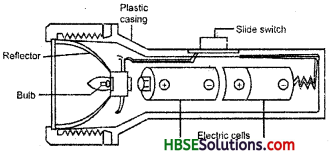
Working of torch:
Electric current flows in the closed circuit. When slide switch is slided forward, cell contact is complete with the bulb, circuit is now closed. Electric current starts from one terminal of the electric cell and comes back to the other terminal of the electric cell. Bulb glows and starts emitting light.
![]()
Question 2.
Describe an electric bulb.
Answer:
It consists of a tiny coiled wire, supported by two thick wires making a V-shape. This tiny coiled wire is called filament. The’ two thick wires making this v-shape are called supporting wires. The lower end of one of these wires is connected to the metal casing at the side of the bulb. The lower end of the second wire is connected to the metal top at the base and the metal casting at its lower end act as terminals of the bulb. The space in between the terminals of the bulb is filled with sealing wax. This prevents the terminals from making contact with one another.
Where the electric current passes through the filament of the bulb through the terminals, it gets white hot and produce light
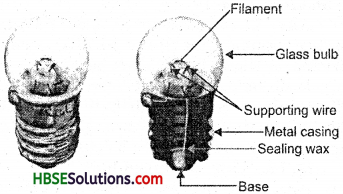
(a) Torch bulb
(b) Inside a torch bulb
Question 3.
What is electric circuit? How many types of electric circuit are there? Define them. Draw a diagram to show the closed Circuit for switch, bulb and dry cell.
Answer:
Electric circuit:
The complete path of flow of electricity from one terminal of the cell to its other terminal through various electrical components is called an electric circuit.
There are two types of electric circuit: (a) Open electric circuit, (b) Closed electric circuit.
(a) Open electric circuit:
The circuit in which electrical contact at any point is broken is called open electric circuit.
(b) Closed electric circuit:
The circuit in which electric current flows from one terminal of a cell or battery to the other is called a closed circuit.
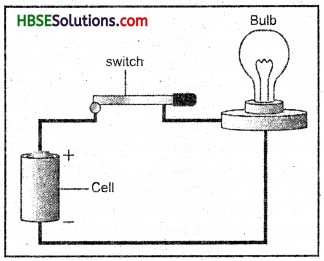
Question 4.
Does supply of electricity have two-way path?
Answer:
Yes . There are always two wires coming from the electric power house. One of the wires brings the current and is called live wire. The current coming through live wire passes through an electric appliance (such as a bulb, fan, etc.) and then flows out through another wire to power house. The wire which carries away the current to power house is called neutral wire.
These days there is a third wire, which is commonly called earth wire. This wire is attached to the metallic bodies of the electric appliances. It is a kind of safety wire which protects us from electric shocks and electric fires.
Electricity and Circuits Class 6 HBSE Notes
- Electricity is the most useful forms of energy. We use many devices which work on electricity such as heater, washing machine, T.V., tube-light, etc.
- Electric cell is a source of electricity. It has two terminals: (i) Positive terminal and negative terminal.
- Electric cell produces electricity from the chemicals stored inside it.
- A bulb has two terminals. The complete path from one terminal of the electric cell through the bulb and back to the other terminal of electric cell is called a circuit.
- When there is a complete circuit from one terminal of the electric cell to the other, electric current flows through the circuit.
- The electric current flows from the positive terminal of the electric cell to its negative terminal.
- Switch is a simple device that either breaks the circuit or completes it to stop or start the flow of current.
- Materials through which the electric current can flow are called conductors;
- Materials through which the electric current cannot flow are called insulators.
- Electric cells are used in many devices such as an alarm clock, wrist-watch, transistor and camera etc.
- When two electric cells are jointed together, we call it a battery.
- In an electric bulb there is a thin wire, called filament and two thick wires.
- Electric circuit: The complete path from one terminal of the electric cell through the bulb and back to other terminal of electric cell, is called a circuit.
- Electric switch: A switch is a simple device that either breaks the circuit or completes it.
- Conductors and insulators are equally important for us.
- Our body is a good conductor of electricity. Therefore be careful when you handle an electrical appliance.